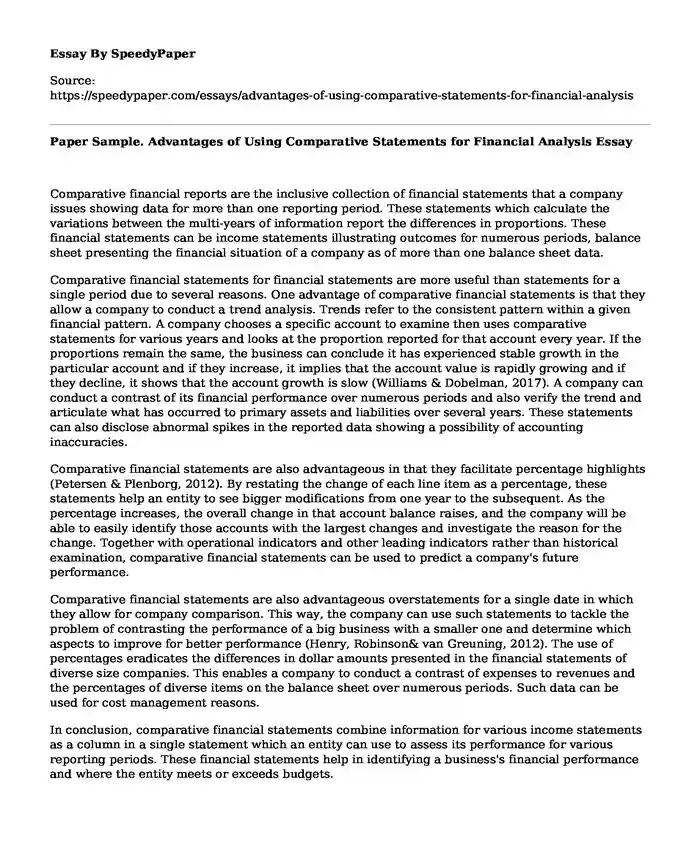
| Type of paper: | Essay |
| Categories: | Business Budgeting Financial analysis |
| Pages: | 3 |
| Wordcount: | 602 words |
Comparative financial reports are the inclusive collection of financial statements that a company issues showing data for more than one reporting period. These statements which calculate the variations between the multi-years of information report the differences in proportions. These financial statements can be income statements illustrating outcomes for numerous periods, balance sheet presenting the financial situation of a company as of more than one balance sheet data.
Comparative financial statements for financial statements are more useful than statements for a single period due to several reasons. One advantage of comparative financial statements is that they allow a company to conduct a trend analysis. Trends refer to the consistent pattern within a given financial pattern. A company chooses a specific account to examine then uses comparative statements for various years and looks at the proportion reported for that account every year. If the proportions remain the same, the business can conclude it has experienced stable growth in the particular account and if they increase, it implies that the account value is rapidly growing and if they decline, it shows that the account growth is slow (Williams & Dobelman, 2017). A company can conduct a contrast of its financial performance over numerous periods and also verify the trend and articulate what has occurred to primary assets and liabilities over several years. These statements can also disclose abnormal spikes in the reported data showing a possibility of accounting inaccuracies.
Comparative financial statements are also advantageous in that they facilitate percentage highlights (Petersen & Plenborg, 2012). By restating the change of each line item as a percentage, these statements help an entity to see bigger modifications from one year to the subsequent. As the percentage increases, the overall change in that account balance raises, and the company will be able to easily identify those accounts with the largest changes and investigate the reason for the change. Together with operational indicators and other leading indicators rather than historical examination, comparative financial statements can be used to predict a company's future performance.
Comparative financial statements are also advantageous overstatements for a single date in which they allow for company comparison. This way, the company can use such statements to tackle the problem of contrasting the performance of a big business with a smaller one and determine which aspects to improve for better performance (Henry, Robinson& van Greuning, 2012). The use of percentages eradicates the differences in dollar amounts presented in the financial statements of diverse size companies. This enables a company to conduct a contrast of expenses to revenues and the percentages of diverse items on the balance sheet over numerous periods. Such data can be used for cost management reasons.
In conclusion, comparative financial statements combine information for various income statements as a column in a single statement which an entity can use to assess its performance for various reporting periods. These financial statements help in identifying a business's financial performance and where the entity meets or exceeds budgets.
References
Henry, E., Robinson, T. R., & van Greuning, J. H. (2012). Financial analysis techniques. Financial reporting & analysis, 327-385. Retrieved from: https://www.cfainstitute.org/-/media/documents/support/programs/cfa/2019-L1V3R26-footnotes.pdf
Petersen, C. V., & Plenborg, T. (2012). Financial statement analysis: valuation, credit analysis, and executive compensation. Pearson Longman. Retrieved from: https://www.forskningsdatabasen.dk/en/catalog/2397957144
Valickova, P., Havranek, T., & Horvath, R. (2015). Financial development and economic growth: A metaanalysis. Journal of Economic Surveys, 29(3), 506-526.doi: https://doi.org/10.1111/joes.12068
Williams, E. E., & Dobelman, J. A. (2017). Financial statement analysis. World Scientific Book Chapters, 109-169.Retrieved from: https://ideas.repec.org/h/wsi/wschap/9789813224261_0004.html
Cite this page
Paper Sample. Advantages of Using Comparative Statements for Financial Analysis. (2023, Mar 22). Retrieved from https://speedypaper.net/essays/advantages-of-using-comparative-statements-for-financial-analysis
Request Removal
If you are the original author of this essay and no longer wish to have it published on the SpeedyPaper website, please click below to request its removal:
- Essay Example on Importance of Nursing Research
- Essay Example on Female Heads of Household
- 13 Reasons Why - Free Essay with the Book Analysis
- Finance Essay Sample on Coca-Cola and PepsiCo
- Essay Example: My Social Development in Middle School
- Free Essay Example. The Genetics of the Origin of Humans
- Free Essay on Marketing Plan: SWOT Analysis
Popular categories




